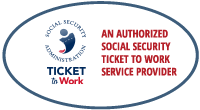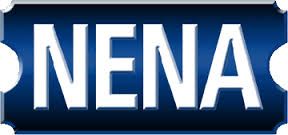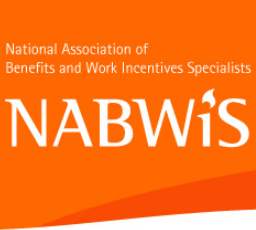-
1619(b) Medicaid
1619(b) is a provision that allows SSI beneficiaries whose earned income is too high to receive an SSI check to maintain Medicaid eligibility. There is no time limit on this status. Individuals in 1619(b) are considered SSI eligible even though they do not receive a check.
-
Beneficiary
A person who is receiving a benefit. For example, an SSDI beneficiary is the person who is entitled to the SSDI Check.
-
Blind Work Expenses
A special income deduction for individuals who are statutorily blind.
-
Cessation and Grace
A Title II Work Incentive. Cessation is the first month SSA determines that a beneficiary has earned at or above Substantial Gainful Activity (SGA) level. Though the individual is earning above SGA, they will receive their SSDI benefit in their month of Cessation plus the two following "Grace" months. Beneficiaries cannot reach Cessation and Grace until they've completed their Trial Work Period (TWP).
-
Childhood Disability Benefit (CDB)
A type of Title II benefit. Individuals who became disabled before age 22 can draw a benefit from the work record of a deceased or retired parent. CDB beneficiaries have the same work incentives and work activity rules as SSDI beneficiaries.
-
Concurrent Beneficiary
Someone who receives both a Title II benefit (SSDI, CDB, or DWB) and Title XVI (SSI) benefits. This usually happens when an individual is entitled to a Title II benefit, but it is less than the Federal Benefit Rate (FBR). The individual receives an SSI benefit to bring their countable income up to the FBR.
-
Countable Earned Income
Your countable earned income is the portion remaining after SSA or DHHS takes your gross earnings and subtracts any available income disregards and work incentives.
-
Countable Income
The portion of an individual's total income (unearned and earned) after disregards and/or work incentives that SSA or DHHS counts when determining benefit amounts or eligibility for certain programs.
-
Countable Unearned Income
Your countable unearned income is the amount remaining after SSA or DHHS takes your gross unearned income and subtracts a General Income Exclusion (GIE) of $20. Usually countable unearned income is part of determining eligibility for SSI, DHHS benefits, and Medicare financial assistance programs.
-
Department of Health and Human Services (DHHS)
The Department of Health and Human Services (DHHS) is the state agency responsible for administering Medicaid, Medicare Savings Programs, SNAP, Energy Assistance, Childcare Subsidies, WIC, and other state level economic assistance programs.
-
Disabled Widow(er) Benefits (DWB)
A type of Title II benefit. Individuals who became disabled before age 50 can draw a benefit from the work record of a deceased spouse. DWB beneficiaries have the same work incentives and work activity rules as SSDI beneficiaries.
-
Earned Income
Income that comes from employment or self-employment.
-
Extended Period of Eligibility (EPE)
A Title II Work Incentive. The EPE is the 36 month period following the last Trial Work Period month. During the EPE, beneficiaries cannot be terminated from benefits based on their earned income during this time. If earnings are below Substantial Gainful Activity (SGA) level, their benefit check continues. However, any months the beneficiary works at SGA level, their check is suspended.
-
Extended Period of Medicare Coverage (EPMC)
A Title II Work Incentive. The EPMC provides continuing Medicare coverage for Title II beneficiaries after terminating from benefits due to work activity. Beneficiaries' Medicare coverage can continue for at least 93 months following the end of the Trial Work Period (TWP).
-
Extra Help
Also known as the Low Income Subsidy (LIS). Extra Help is a program administered by Social Security that provides assistance with Medicare Part D premiums and in some cases, out-of-pocket costs. Eligibility is automatic for full Medicaid beneficiaries, and individuals can also qualify by meeting income and resource requirements. There are two levels of assistance, Full and Partial.
-
Federal Benefit Rate (FBR)
The Federal Benefit Rate is the maximum monthly SSI benefit amount. There is an individual FBR and a couples' FBR. The amounts usually change annually. 2019 FBR: $771 Individual, $1157 Eligible Couples
-
Gross Earnings
Your earnings before taxes and deductions are taken out.
-
Impairment Related Work Expense (IRWE)
IRWEs are certain out-of-pocket expenses an individual must incur in order to work, and can be used as a disregard to reduce countable income. This disregard can be used by working SSI beneficiaries to keep more of their SSI check, or by Title II (SSDI/CDB/DWB) beneficiaries to reduce their earnings below SGA level.
-
Low Income Subsidy (LIS)
See "Extra Help."
-
Medicaid
A joint federal-state run medical insurance program. In Nebraska, Medicaid is focused on low income families, seniors, and individuals with disabilities. While Nebraska voters approved Initiative 427 to expand Medicaid eligibility in Nebraska, the expansion has not been implemented yet.
-
Medicare
A federally run medical insurance program for seniors and certain individuals with disabilities. Title II disability beneficiaries will become eligible for Medicare after a 24-month waiting period beginning the date of entitlement to benefits. There are different Parts of Medicare.
-
Medicare Part A
Part A is hospital insurance. It is usually premium free for Title II beneficiaries.
-
Medicare Part B
Part B is medical insurance. It is optional and there is a premium for coverage that usually changes annually. The Part B premium is either deducted from the Title II benefit, billed quarterly, or is paid for by a Medicare Savings Program (MSP).
-
Medicare Part D
Part D is prescription drug coverage available to people who have Part A or are enrolled in both Part A and Part B. It is completely optional and beneficiaries choose from a number of private plans available in their area. The various plans differ in cost and what drugs they cover. Extra Help/LIS is the Medicare financial assistance program associated with Part D, and is administered by SSA.
-
Medicare Savings Programs (MSP)
Medicare Savings Programs provide assistance paying the Medicare Part B premium. Eligibility is automatic for full Medicaid beneficiaries. Individuals not receiving Medicaid can be eligible based on meeting program income/resource guidelines. The MSPs are administered by DHHS.
-
Net
When referring to an amount, net is the amount remaining after deductions are subtracted from the gross amount.
-
Plan to Achieve Self-Support (PASS)
PASS is a work incentive program offered through SSI. Beneficiaries may develop a plan to work off Title II benefits and/or substantially reduce their dependence on SSI. In the plan they must detail their goal, the steps they will take to reach the goal, and the items/services they will need to reach the goal. If the plan is approved, they are allowed to set aside their countable income to pay for their PASS expenses. That PASS deduction cancels out their countable income in the SSI calculation, allowing them to receive a full SSI check for their living expenses while working on their PASS goal.
-
Premium-HI for the Working Disabled
Premium Health Insurance for the Working Disabled is a program available to individuals who have worked off their Title II benefit AND completed their Extended Period of Medicare Coverage (EPMC). If the individual receives Medicare Savings Programs assistance (for Part B) or Extra Help (for Part D), this can continue to apply. However, individuals usually have to start paying a Part A premium. Certain individuals can qualify to pay a reduced Part A Premium.
-
Social Security Administration (SSA)
The SSA is responsible for administering Title II and SSI benefits, as well as the Extra Help program.
-
Social Security Disability Insurance (SSDI)
A Title II benefit. SSDI is a federal disability insurance benefit based upon a beneficiary's own work history. SSDI beneficiaries have earned enough work credits to have attained insured status. Benefit amounts are based upon your contributions to the Social Security Trust Fund (FICA) through your work history.
-
Student Earned Income Exclusion (SEIE)
The SEIE allows individuals with disabilities who are under age 22 and attending an educational program full time to exclude a significant portion of their earnings each month, up to an annual maximum. In 2019, students may exclude up to $1,870 per month in earnings, up to an annual maximum of $7,550.
-
Subsidy & Special Condition
A Title II Work incentive. Subsidies and special conditions are extra support that a beneficiary receives on the job that results in their receiving more pay than the actual value of the services performed. SSA determines the value of any subsidies/special conditions and deducts it from your earnings when they decide if you're working at SGA level. Examples include job coaching, extra supervision, extra breaks, extra time to complete your work, or being given a job with fewer or simpler tasks to complete than other workers.
-
Substantial Gainful Activity (SGA)
SGA is an amount used as a guideline by SSA when determining if a Title II beneficiary is capable of working at a substantial level. SSA starts evaluating a beneficiary's earnings against the SGA guideline after they have completed their TWP. The first time SSA finds that a beneficiary has worked at SGA level triggers Cessation and Grace.
-
Supplemental Nutrition Assistance Program (SNAP)
Commonly known as "food stamps." This program provides cash assistance to low income families, seniors, and individuals with disabilities to be used toward food.
-
Supplemental Security Income (SSI)
A Title XVI benefit. The SSI program makes cash assistance payments to aged, blind, and disabled persons who have limited income and resources. Individuals who receive SSI either do not have insured status for a Title II benefit, or their Title II benefit is less than the Federal Benefit Rate (FBR). SSI benefits are paid out of general tax revenue, NOT the Social Security Trust Fund.
-
Title II Benefits
Benefits received under Title II of the Social Security Act, including SSDI, CDB, and DWB. These benefits are paid out of the Social Security Trust Fund and are based on work history - SSDI from the beneficiary's work record, CDB from the beneficiary's deceased or retired parent's work record, and DWB from the beneficiary's deceased spouse's work record.
-
Title II Work Incentives
A series of work incentive phases that offer Title II beneficiaries varying degrees of protection from losing their benefits due to earnings. Title II Work Incentives include Trial Work Period (TWP), Extended Period of Eligibility (EPE), Cessation & Grace, and the Extended Period of Medicare Coverage (EPMC).
-
Trial Work Period (TWP)
The first Title II work incentive phase. Title II beneficiaries get 9 TWP months, which do not have to be used consecutively. Beneficiaries initiate TWP usage by earning gross wages over the TWP level. TWP level usually changes annually (2019: $880 or 80 hours of self-employment work). Additionally, the 9 TWP months must be used within a 60-month rolling period, so TWP months can drop off your record after five years if you have not completed the TWP.
-
Unearned Income
Any income that does not come from employment or self-employment. Unearned income includes (but is not limited to) Title II benefits, money from legal settlements, alimony, spousal or child support payments.
-
Unsuccessful Work Attempt (UWA)
A UWA is a when a beneficiary who is employed or self-employed, but their work stops or earnings drop below SGA after six months or less because of their disability or removal of impairment-related special conditions that are essential for the person to keep working.
Resources and Other Places to Get Help

Glossary of Terms
-
Ticket to WorkAn authorized Social Security Ticket to Work Service Provider




